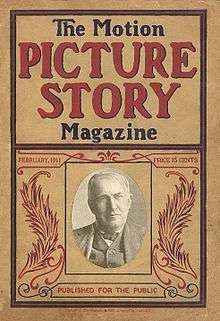Motion Picture Magazine
Motion Picture was an American monthly fan magazine about film, published from 1911 to 1977.[1] It was later published by Macfadden Publications.
 Front cover of the first issue of The Motion Picture Story Magazine (February 1911) | |
| Categories | Fan magazine |
|---|---|
| Frequency | Monthly |
| Publisher | M. P. Publishing Company, Inc. |
| Year founded | 1911 |
| Final issue | 1977 |
| Country | United States |
| Language | English |
History and profile
The magazine was established by Vitagraph Studios co-founder J. Stuart Blackton and partner Eugene V. Brewster under the title The Motion Picture Story Magazine.[2] In contrast to earlier film magazines such as The Moving Picture World, which were aimed at film exhibitors, The Motion Picture Story Magazine was aimed at regular film goers. It has been regarded as the first fan magazine.[3]
The magazine was very successful from its inception, with an initial run of 50,000 copies and a circulation of 200,000 by 1914. Writers were amazed at the outset to receive their checks for contributions almost immediately on acceptance, a policy on the part of Brewster that was effective in quickly inducing the highest grade fiction authors to become affiliated with the publication. Contributors included Rex Beach, Will Carleton and Horatio C. King.[4]
The magazine's most successful column was entitled "The Answer Man" (written by a woman) that answered readers' questions about the film world. This was an innovation, the first of its kind in journalism.[4]
In 1914, it was renamed Motion Picture Magazine. Early editions included fiction and information on how to get involved in film production. The magazine shifted to a focus on celebrities and attracted a larger female readership. In 1919, the circulation jumped from 248,845 to 400,000.[5]
Its sister publication Motion Picture Classic, which was started as its supplement,[6] was published monthly from September 1915 to March 1931. In 1941, Motion Picture Magazine merged with Hollywood and Screen Life and continued to be published for almost four more decades, ending its run in 1977.
References
- Fuller, Kathryn H. “Motion Picture Story Magazine and the Gendered Construction of the Movie Fan.” At the Picture Show: Small-Town Audiences and the Creation of Movie Fan Culture. Smithsonian Institution: Washington, 1996. pp. 133–149.
- "Motion Picture Magazine". The Online Books Page. Retrieved April 24, 2016.
- Pamela Hutchinson (January 26, 2016). "Photoplay magazine: the birth of celebrity culture". The Guardian. Retrieved September 13, 2018.
- Robert Grau (1914) The Theatre of Science: A Volume of Progress and Achievement in the Motion Picture Industry, Broadway Publishing Company, New York
- Bordwell, David (1985). The Classic Hollywood Cinema: Film Style and Mode of Production to 1960, p. 99. Columbia University Press ISBN 978-0-231-06055-4
- Heather Addison (2003). Hollywood and the Rise of Physical Culture. Psychology Press. p. 42. ISBN 978-0-415-94676-6.
External links
| Wikimedia Commons has media related to Motion Picture. |